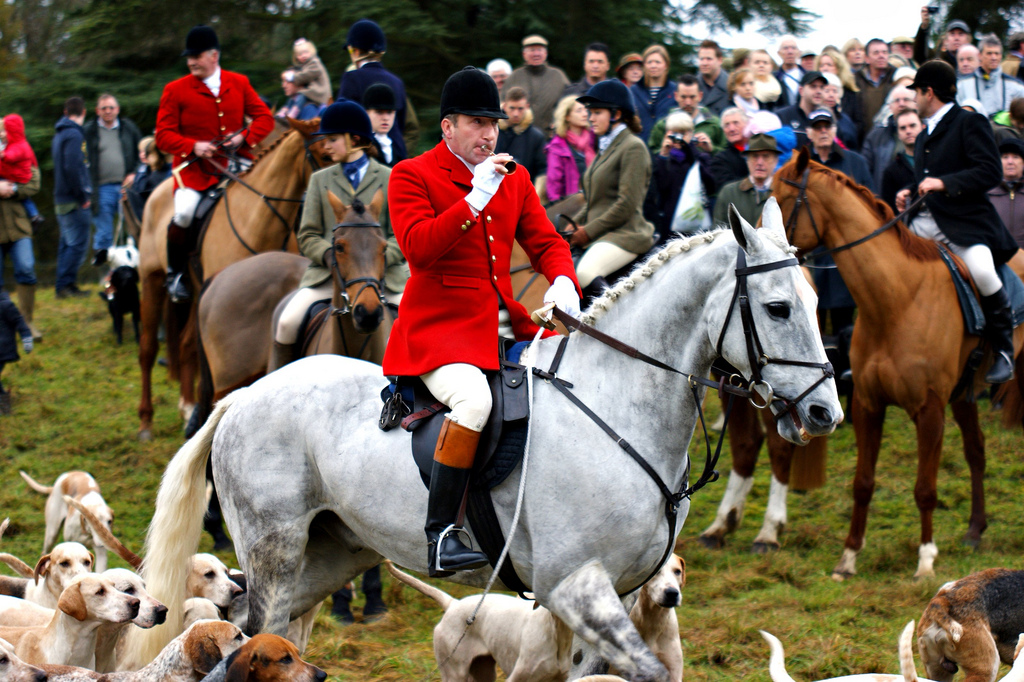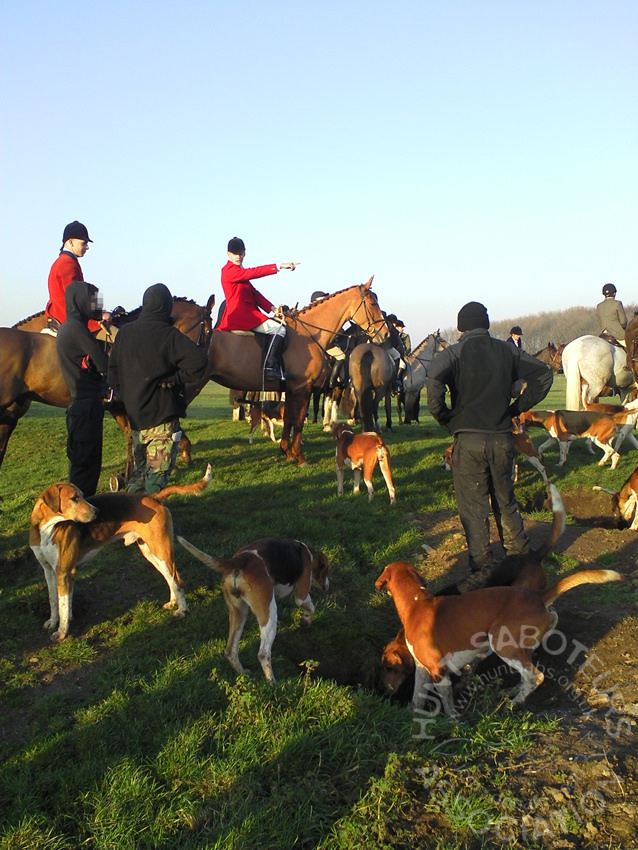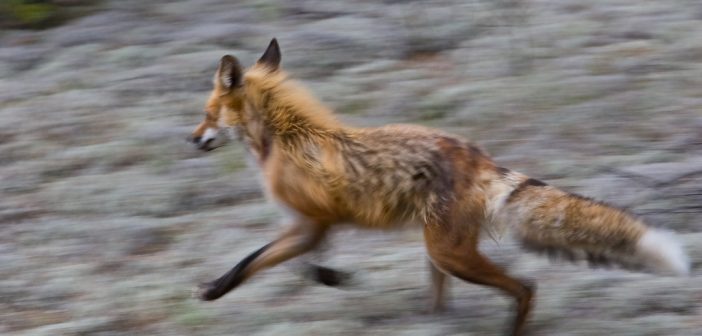(Featured image credit: Calypso Orchid, used under CC BY-NC-ND 2.0)
There are ten particular situations that every Sab needs to know about. If you know the calls, you will not be bored at a Hunt, as you will be able to know what is happening. You will also be much better prepared to Sab effectively. After a few months every Sab in a group should be able to identify which of these 10 situations is happening! The Tactics Officer can ask questions to make sure all Sabs know their ten essential Hunt situations.
To the hounds the Huntsman is Mr. Nice, who speaks in a higher tone and encourages them. He gives them the reward of breaking up the fox. The 1st and 2nd Whip are Mr. Nasty to the hounds. They use the whip on the hounds (I do not know how this is legal). And they use harsh angry cries to stop the Hounds if they are going the wrong direction. They use a deeper tone than the Huntsman. Besides voice and whips, horn calls are also used to pass on messages to both hounds and Hunt followers.
__
One. Drawing Covert. When the Huntsman is Drawing Covert (sending hounds into a wood to get the Fox’s scent) he sends them in shouting, “Eleu In, Eleu In, Eleu In.” Emphasis on the “In.” “Cover Hike!” also sends hounds into covert. He may also use single notes on the horn to keep the hounds together. The cry, “Yoi-Over” (emphasis on the “ovER”!) encourages the hounds to go over a fence or other obstacle. “Edawick, Edawick, Edawick,” encourages the hounds to hunt for scent in the covert. Some of these calls are coarsely spoken and need to be heard a few times before being identified.

Huntsman calling with horn (photo credit: Not enough megapixels, used under CC BY-NC-ND 2.0)
Two. Leaving Covert. If no foxes are found in the wood, the huntsman will pull the hounds out with a “Leaving Covert” horn call. This varies from Hunt to Hunt, but at my local hunt is a medium length (four seconds) call with three peaks in it. It is blown three times. This also lets the Field know that they are moving to another covert.
Three. Blowing Out. When the Huntsman has decided to move to a completely different area, he lets the Hounds, Staff, and the Field know this by blowing a long rising and flowing note called, “Blowing Out”. It is blown three times. If you hear this then you know that the Hunt are moving off.
Four. Blowing Away. This is similar to Blowing Out but is augmented by the addition of sharp staccato doubling. This is when the Hunt is leaving, but to hunt a fox that has been seen.
Five. Stopping hounds with Horn and Voice. A whipper-in will use voice calls and the whip to stop hounds going after the wrong type of prey species (e.g. rabbit or deer) and this is where hounds are said to Riot. This call is loud and harsh, “War-Riot!” Here the tone of anger in the voice is as important as the words. Hounds pick up meaning from the tone of the commands. “Have a care!” or “Leave it!” may also be used. The huntsman can stop hounds by blowing a harsh call on the horn (called a discord). The note is harsh, even in volume, and about five seconds long. It is blown three times. It can be blown by placing two fingers in the bell of the horn.
Six. Putting hounds onto a scent. If a hound finds the scent, the Huntsman will cry out to the other hounds, “Hike, Hike, Hike, Hike to Governor”, (or whatever the name of the hound is.) He will encourage the hounds onward with, “Hike, Hike, Hike, Forrard, Forrard”. Or, “On and On, and On and On…” The cry, “Hike Together” asks hounds to gather with another group of hounds that are on the scent of the fox. If the hounds are chasing the fox then the Huntsman may encourage them with a series of short rapid staccato notes known as, Doubling. If you hear fast excited notes then it tends to mean that the fox is being hunted or killed.
Seven. Fox Sighted. When the Whipper-in (or even a member of the Field) sees a fox leave covert without the hounds being on the scent, he will draw everyone’s (Huntsman’s, Hound’s, and Field’s) attention to this with a cry known as a “Holloa”. The person crying out will also point in the direction of the fox. This long cry gets louder towards the end and sounds like a screamed, “weeeeeuGGGHHHH!!!” The cry rises sharply in tone at the end. This scream is very important to know. In some Hunts the Whip or a member of the Field may also loudly cry, “Taaally Oh, Taaally Oh, Go-o-n-e Away-y-y-y-y!”
Eight. The Kill. This is a medium length note (6 seconds) in which the horn is shaken against the lips (to achieve a tremolo sound). This call starts quiet but gets progressively louder. The death halloa may also be shouted at this time, “Who-o-o-op!” Shouted three times.
Nine. Gone to Ground. Sounds a bit like the long note of Blowing Away but with the tremolo (quickly vibrating) sound of the Kill added at the end. Blown three times. It is used when a fox has sought refuge in a hole in the ground or somewhere else inaccessible.
Ten. Blowing for Home. This is one long extended sad winding note: blown at the end of a day’s hunting.
__
The horn and voice calls vary slightly between Hunts. Please keep a small notebook to collect them for your own use. Every horn and voice call used at the Hunt has an essential purpose.
A useful website where you can hear these sounds is at:
http://nwhsa.redblackandgreen.net/horn.html
By learning all of the calls, Sabs can use them to disrupt a Hunt. The holloa can be made to attract hounds. Encouraging hounds (“On and on, On and On…”) and using their names can lead stray hounds away from the Hunt. Using a “War-Riot!” call can stop hounds in pursuit of a fox. A Discord can also be blown on the horn.
ADVICE FOR YOUR DAY OF SABOTAGE
Everyone must have waterproof clothes with them (no jeans), a mobile phone, and food and water.

Saboteurs confront hunters (photo credit: Hunt Sabs, used under CC BY-NC-SA 2.0)
NEVER be on your own. If pestered by someone say, “I am not offering violence. I have a witness and we already have a picture of you. This will go to Court in six months. Is that what you want?”
Never put hounds onto a fox. Do not call hounds towards a road or railway. Be polite to Hunt members but don’t talk too much (they will try and keep you stationary). The hounds are nice (to people), but beware of horses with a red ribbon around their tail (as they kick). It is useful to know the names of the hounds, not to place a name to a specific hound in every case, but so you can call out names to the whole pack when you are trying to attract them over to you.
You need:
- A Press Officer to take pictures.
- 2 mini-bus drivers who stay with the van. They should have mobile phone numbers, mobile phones, and a walkie talkie.
- A Running Group who keep up with the hounds through the woods. This is dangerous and tiring. Use horn and voice calls, and anti-mate to disrupt the hounds’ sense of smell.
- A Van Group. Stays near the van and notes names of hounds and calls used. Uses horn and voice calls and anti-mate, and takes pictures/films of everyone suspicious in case of a crime.
If possible, arrange for two people to do each job. Partly in case one leaves, but also to train one person up. Have 2 each of tactics officers, fundraisers, Hunt Diary officers who can each use a compass (keeping details of where the Hunt went and what woods were hunted). Have 2 Sab coordinators, to phone people to see if they can attend the Sab and tell them where to meet – they also need the Internet as some Hunts advertise on the web. Also have 2 Media people, and 1 treasurer and 1 secretary.
You need an arranged and agreed strategy to deal with a Dig Out. This is a dangerous time! Film this. Also film if possible Hunt Staff encouraging hounds to hunt. And film the marksmen.
You need an arranged and agreed strategy to deal with the marksmen, because they are potentially dangerous to Sabs.
Also arrange a rendezvous point if people get lost and have no phone signal. Both Sab groups (running and van) should have the same good quality detailed map. As many people as possible should have a map and compass and know how to use both.
At the end of the Hunt, write a report with the Diary Officer of what woods were hunted and how many foxes killed and where. Note (for yourselves) witnesses of any incidents. Detail what tactics worked and what horn and voice calls the Hunt used.





